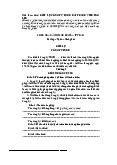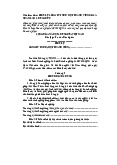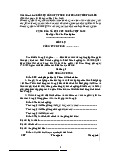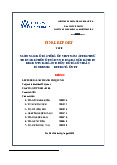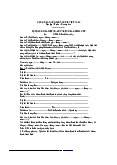



















Preview text:
MINISTRY OF EDUCATION AND TRAINING HOA SEN UNIVERSITY
FACULTY OF ECONOMICS AND BUSINESS FINAL REPORT INTERNATIONAL PAYMENT Lectures : Lâm Thanh Phi Quỳnh Class : NT317DE01 Group : 03 Members : Trần Bích Nhân (2183674)
Trần Nguyễn Quỳnh Mai (2181692) Châu Thị Băng Châu (2182699) Nguyễn Vy Trâm Anh (2170439)
Phạm Thị Ngọc Thắm (2001819) Võ Minh Duy (2181790) Nguyễn Lý Minh Thư (2172866)
Hồ Chí Minh City, August, 2021
MINISTRY OF EDUCATION AND TRAINING HOA SEN UNIVERSITY
FACULTY OF ECONOMICS AND BUSINESS FINAL REPORT INTERNATIONAL PAYMENT Lectures : Lâm Thanh Phi Quỳnh Class : NT317DE01 Group : 03 Members : Trần Bích Nhân (2183674)
Trần Nguyễn Quỳnh Mai (2181692) Châu Thị Băng Châu (2182699) Nguyễn Vy Trâm Anh (2170439)
Phạm Thị Ngọc Thắm (2001819) Võ Minh Duy (2181790) Nguyễn Lý Minh Thư (2172866) ĐIỂM 7.5 2
Hồ Chí Minh City, August, 2021 3 DISCLAIMER
“We have read and understand violations of academic integrity.
We pledge with personal honor that this work was done on our own
and does not violate academic integrity.”
Date____ month ____ year ______ (Student's name and signature) 4 INTRODUCTION
Facing the trend of the world economy becoming increasingly
internationalized, Vietnam is developing a market economy, opening up,
cooperating and integrating. In the first scenario, international trade and
investment activities emerge as a bridge connecting the domestic economy with
the outside world. To perform this function, connect international banks such as
Import-Export Finance, Foreign Exchange Business, Bank Guarantees in Foreign
Trade, International Payments, especially payments by L/ C… serves as an
essential tool and is becoming increasingly important. On this day, international
payment is an increasingly important service for Vietnamese commercial banks,
an important link in promoting the development of other business activities of the
bank, and ending support and supporting the export - import business activities of
developed enterprises. International payment was born on the basis of
international trade, but whether international trade exists and develops or not
depends on and the payment manager has all information, time, safety. and
correct or not. International trade and payments is inherently complex and risky
compared to domestic trade and payments, because it is governed by local laws
and customs, but also international and national laws.
Therefore, stakeholders and participants in the process of International Trade and
Payment need to have a thorough understanding of not only the technical and
professional processes but also local and international practices, customs, and
laws. economic. The essay with the topic "Causes for commercial banks to
evaluate solvency" of the group 03-08, we study the concepts as well as the
causes of one of the international payment methods- with the goal of helping
people understand and grasp and apply this method in a reasonable and accurate
way. Although we have tried to collect and concentrate our knowledge, our team
still cannot avoid mistakes. We sincerely thank you and look forward to receiving your comments! TABLE OF CONTEN 5
INTRODUCTION...............................................................................................4
TABLE OF CONTENT......................................................................................5
PART 1. THEORETICAL BASIS......................................................................6
1.1. The concept of a bank's credit line, classification......................................6
1.2. What issues do banks usually consider when appraising credit lines
(conditions when appraising limits for businesses)...........................................6
1.3. What is escrow? Classification....................................................................7
Definition:.......................................................................................................... 7
Types of deposit:................................................................................................7 a)
L/C Open Margin:....................................................................................8
b) Guarantee deposit for contract execution:................................................8
c) Margin for multi-industry business purposes:..........................................8
1.4. Conditions when opening Escrow L/C? Notes when depositing to open
LC?....................................................................................................................... 9
Condition:..........................................................................................................9
Notes:............................................................................................................... 10
1.5. The process of depositing funds.................................................................11
It should be noted that:.....................................................................................11
Step 1: Apply for a letter of credit (L/C)..........................................................12
Step 2: The main bank accepts the application and opens a letter of credit for
the business...................................................................................................... 14
Step 3: The banking system operates, transferring letters of credit to partners
and beneficiaries..............................................................................................15
1.6. The benefits when depositing L/C.............................................................15
PART 2. ANSWER THE QUESTION.............................................................18
CONCLUSION..................................................................................................19 6
PART 1. THEORETICAL BASIS
1.1. The concept of a bank's credit line, classification.
A committed credit line is a monetary spending loan balance offered by a
financial institution that cannot be suspended without notifying the borrower. A
committed credit line is a legal agreement outlining the conditions of the credit
line between the financial institution and the borrower.
1.2. What issues do banks usually consider when appraising credit lines
(conditions when appraising limits for businesses)
Depending on each bank, there will be different conditions, but there will be the following main conditions:
● Domestic enterprises have a continuous business period of 12 months or
more from the time of registration. Or have local confirmation of the
actual business time from 12 months.
● Business registration lines are suitable for borrowing loans, business plans,...
● Have a viable business plan, have the full financial capacity, and clear source of repayment.
● Having secured assets with loan security value.
● There are no bad debts at banks or other credit institutions.
Banks often consider what issues to consider when evaluating credit limit commitments :
● First, pay attention to the determining side of the business: grasp the
capacity of the operator, the competitive power of the product, the technical strength…
● Second, quantitative analysis without depending on financial information:
even if financial information is not available, by various methods it is
necessary to grasp and analyze the financial situation of the business. 7
Moreover, it is required to check the suitability between items, the
suitability of the quantitative side compared to quantitative numbers.
● Thirdly, analyze the purpose of using loans: after grasping the situation of
the enterprise, conducting a project analysis based on short-term forecasts.
1.3. What is escrow? Classification. Definition:
An escrow is an amount of money, gemstone or some related important
papers taken into an account, then blocked, strictly controlled in the bank for the
purpose of guaranteeing companies and organizations, when doing projects or investing.
Escrow deposits can be money or precious metals, gems, or valuable papers
that are frozen in banks or credit institutions to ensure the performance of obligations.
Escrow is a legal concept describing a financial instrument whereby an
asset or escrow money is held by a third party on behalf of two other parties that
are in the process of completing a transaction. Escrow accounts might include
escrow fees managed by agents who hold the funds or assets until receiving
appropriate instructions or until the fulfillment of predetermined contractual
obligations. Money, securities, funds, and other assets can all be held in escrow.
It is often suggested as a replacement for a certified or cashier's check.
Escrow is a process used when two parties are in the process of completing
a transaction, and there is uncertainty over whether one party or another will be
able to fulfill their obligations. Contexts that use escrow include Internet
transactions, banking, intellectual property, real estate, mergers and acquisitions, and law, and many more.
Types of deposit: 8
There are 3 most common types of deposit that are commonly seen as L/C
Open Margin, Guarantee deposit for contract execution, Margin for multi- industry business purposes. 9
a) L/C Open Margin:
A letter of credit, or "credit letter" is a letter from a bank guaranteeing that a
buyer's payment to a seller will be received on time and for the correct amount.
In the event that the buyer is unable to make a payment on the purchase, the bank
will be required to cover the full or remaining amount of the purchase. It may be offered as a facility.
Due to the nature of international dealings, including factors such as
distance, differing laws in each country, and difficulty in knowing each party
personally, the use of letters of credit has become a very important aspect of international trade.
L/C is made by the bank and is valid as a letter at the mutual request of the
parties. Contents of L/C are agreements and commitments to pay goods to the exporter.
b) Guarantee deposit for contract execution:
This form is often applied to large-scale construction works with huge
costs. The deposit will be agreed between the investor and the contractor.
Usually, the owner will be forced to deposit with the bank to ensure that the
project is done with the right quality and on schedule. During the construction
process, if there is a problem that is not self-resolved, the investor will use this
deposit to fix and compensate for the damage to the work.
This is a fairly secure form of deposit for both the investor and the project.
This is a safe transaction for both parties to ensure that all issues are followed in a predictable order.
c) Margin for multi-industry business purposes:
A formal technique to secure business and in case of disruption or
production in some fields and other industries.
The reason for this escrow format is because throughout the business
process, the investor must ensure to maintain the minimum amount. 10
1.4. Conditions when opening Escrow L/C? Notes when depositing to open LC? Condition:
- Ensure sufficient capital to pay the LC open fund: Ensure that the LC open fund
can be paid and meet the requirements of the bank:
- In case the Customer does not need to sign 100% or is required to waive or
reduce the deposit, you need to contact the credit side for approval and approval by an authorized person.
- Open-ended fund LC is issued with loan capital of the bank. For this request,
the customer must also contact the credit appraisal department.
Provide complete information in the application file for opening LC: The
application form for opening LC includes: - Application for opening LC.
- For businesses using the service for the first time, it is necessary to provide a
business establishment decision. - Business license.
- Import and export registration number.
- Original foreign trade contract. (In case the contract is signed via FAX, it is
necessary to sign and stamp on the photocopy).
- Import entrustment contract (if any).
- Import license from the Ministry of Trade (For imported items under the
management list specified in the Prime Minister's annual import and export management decision). 11
- Commitment to implementation and payment, credit contract (in case of loan),
official letter approving the opening of the bank's deferred payment LC fund.
- Foreign currency transaction contract (if any).
- An explanation for opening LC made by the credit department of the bank
branch and approved by the authorized director (For the case of deposit under 100% of the LC value).
The above required documents need to submit a photocopy with the
enterprise's stamp and present the original for verification. Documents required to provide originals are: + Commitment to pay + Loan contract
+ Foreign currency trading contract
+ Application for opening LC of the importing side + LC . open explanation Notes : - Escrow object:
According to Vietnam's Civil Law, the approved LC depositors are gems,
money, metals or valuable papers. In particular, the objects when deposited in
the bank must have a value much larger than the scope of the obligation required
to perform. If the customer does not perform the obligations properly, the value
of this account will only be used to solve the arising problems. The remaining
amount will be applied to calculate interest after performing the remaining obligations. 12
- Carrying out escrow measures:
This method of depositing escrow proves the existence of an intermediary
in a legal relationship.In which, the bank is an intermediary to protect the
interests of the exporter and importer. In addition, the bank is also the place
where each party is required to strictly comply with the contractual agreement
and is entitled to collect a service fee from the escrow subject to open the LC.
1.5. The process of depositing funds.
A letter of credit ( L/C ) is a legal document issued by a financial institution
(usually a bank) to provide a guarantee of payment to a beneficiary or accepts
draft drawn by him to the extent that it is on the basis that the beneficiary must
meet the terms of the letter of credit.
And if you are a domestic Importer, you must be interested in learning
about how to open a letter of credit to a foreign exporter. In this article, I will
detail the steps in practice for you to successfully open LC right from the first transaction with the bank.
In fact, the process of opening L/C is very simple with only three steps: Step 1: Apply open L/C
Step 2: The main bank accepts the application and opens a letter of credit for the business
Step 3: The banking system operates, transferring letters of credit to partners and beneficiaries.
Although there are only three simple steps, it is not easy to open an L/C in
both business and banking positions. Why is that? To understand that we will go deeper into the above steps.
It should be noted that:
1. Each bank has its own, different credit opening application form. Enterprises
wishing to open letters of credit must first select the bank they want to open L/C
with. That bank may be a very familiar bank and have transacted with businesses 13
many times, or it may be a strange bank. At that time, the procedure for applying
to open a business may be very different. Therefore, businesses must carefully
study the application form of the selected bank, and carefully read the procedures
and regulations that the bank has prescribed.
2. Application for opening letter of credit must be in writing at least 2 copies.
After the Bank stamps and returns to the unit a copy
3. It is necessary to pay attention to the type of letter of credit that the business
needs and wants to open. Banks will have different ways of providing L/C
services. Most banks have deferred L/C, L/C at sight. Besides, there are also
types of L/C backup, transferable, back-to-back, cyclical, reciprocal ....
Therefore, businesses need to carefully select and complete them in accordance
with the requirements, procedures and documents of the bank.
4. Be careful and consider carefully when setting out the conditions binding on the exporting party.
Avoid conflicts with the terms signed in the contract. “Because the bank opens
L/C at the request of the importer, so you should carefully review the contract
content to ensure that there are no conflicts when putting it in the L/C.”
5. The application for credit is the legal basis for settling disputes between the
applicant for the letter of credit and the issuing bank and the basis for the opening
bank to send the credit to the exporter.
6. In addition, when conducting registration to open L/C, businesses need to pay
attention to their bank's requirements on deposit, guarantee, authorization.
Step 1: Apply for a letter of credit (L/C)
Based on the foreign trade contract (or offer invoice), the importing
organization shall actively write an application for opening a letter of credit and
send it to the serving bank. Profiles usually include: 14
Application for opening L/C
Foreign trade contract (original/copy)
Import license of the Ministry of Trade (if the imported goods are on the
list of management specified in the Prime Minister's annual import and export management decision)
Foreign currency purchase and sale contract (if any) 15
Step 2: The main bank accepts the application and opens a letter of credit for the business.
If agree, the bank stamps the application for opening letter of credit and
returns one copy to the unit. After that, the bank deducts the account of the credit
account opening unit (deposit 100% of the value of the letter of credit in case of
immediate payment or X% of the value of the letter of credit in the case of term 16
payment). The Bank then writes a letter of credit to the exporting organization
through the advising bank in the country of the exporting country.
The opening of a letter of credit can be done by air, by post or by telegram, using the Swift system. Attention:
After the bank has approved, one thing that businesses need to pay attention
to is the transaction fee. Each bank, each type of transaction has different fees
depending on the regulations and nature. Therefore, businesses must consider the
choice to best suit their own ability to meet.
Step 3: The banking system operates, transferring letters of credit to partners
and beneficiaries.
The bank opening the L/C sends a letter of credit to the exporter's
representative bank, the exporter through the system of advising banks (2 advising banks).
It is the responsibility of all banks that belong to the intermediary position
to check the authenticity of the L/C.
At the advising bank, when receiving the letter of credit, it must check and
confirm the L/C opening and then transfer the original to the exporter in verbatim form.
Any L/C must be strictly checked for authenticity, content, signature, test
code before it is delivered to the beneficiary. If there is any error, the advising
bank has the right not to transfer the L/C and must immediately contact the bank
opening the L/C, re-transfer the L/C as quickly as possible, without delay.
These are the three steps in the L/C opening process. Of these three steps,
step one is an important premise of the remaining steps. this requires the
attention, care, effort ... of both businesses and banks. This is also the reason why
opening L/C seems simple, but it's not simple at all. 17
1.6. The benefits when depositing L/C
a. Characteristics
● Currency: VND or foreign currency like USD, EUR, GBP.
● Margin deposit amount: Flexible based on the nature of each type of deposit.
● Interest payment term: Margin can be paid interest within 1 to 36 months.
The longer the payment term, the higher the interest rate.
● Interest rate: Margin deposit is charged at interest rate with term or
demand. Deposit products apply interest payment in the form of deposit
with flexible principal withdrawal. The principal part will be withdrawn if
the interest rate is indefinite and the remaining principal will still enjoy the original interest rate.
● Interest payment method: For accounts with demand interest rate, interest
will be paid on the 25th of every month. Accompanied by a notice stating
"Yes" to the account "Deposit with no term". As for accounts with term
interest payments, the interest will be paid at the end of the period and
automatically entered into the capital.
Note that when using a margin account, you can only open 1 account for
each type of margin and make transactions on that account. One account cannot
be used for all types of bank deposits. b. Benifit only
When making a deposit, your business and organization will receive greater
benefits and benefits than not making a deposit:
● Build credibility with customers.
● Profitability from the balance in the account.
● Ensuring safety for the development of organizations and businesses.
● Organizations and businesses create prestige, assurance and bring peace of mind to business partners. 18
● Money deposited in the Bank can still generate interest in the bank account.
● For business psychology, escrow brings safety and comfort to
organizations, businesses as well as partners.
● Business activities develop smoothly, there is no high risk of default or
bad debt. Therefore, the company's finances are also guaranteed.
● Create higher trust and credibility for customers.
● Profitability for the balance in the account.
● Ensure the safe and sustainable development of organizations and businesses. 19
PART 2. ANSWER THE QUESTION Q uestion :
The reason why some commercial banks also require L/C applicants to
deposit a certain sum of money in their bank account even though these
companies have been provided a credit commiTment at these banks? Ans wer :
Commercial banks often require businesses to deposit an amount of money
even though the business already has a line of credit at the bank because:
In case the business signs a contract with a completely new partner, to
ensure the safety in the cooperation process, the partner company will require the
enterprise to have an intermediary bank to guarantee the contract performance of
the enterprise; if the enterprise complies with the contract, after the expiry of the
guarantee period, the bank will refund the deposit, but if the enterprise does not
comply with the terms signed with the partner in the contract, the the bank will
be the party to indemnify the amount originally guaranteed when performing the contract. Example:
For example, the importing party (Company A) wants to buy a shipment of
furniture with a price of 30 billion VND, which is processed by the exporter
(Company B). Besides, company A does not want to transfer money to company
B in advance to avoid being scammed, company B also does not want to give the
entire shipment to company A for the same reason. Therefore, company A will
ask the bank to make a L/C and commit to make payment to company B at the request of company B. 20
